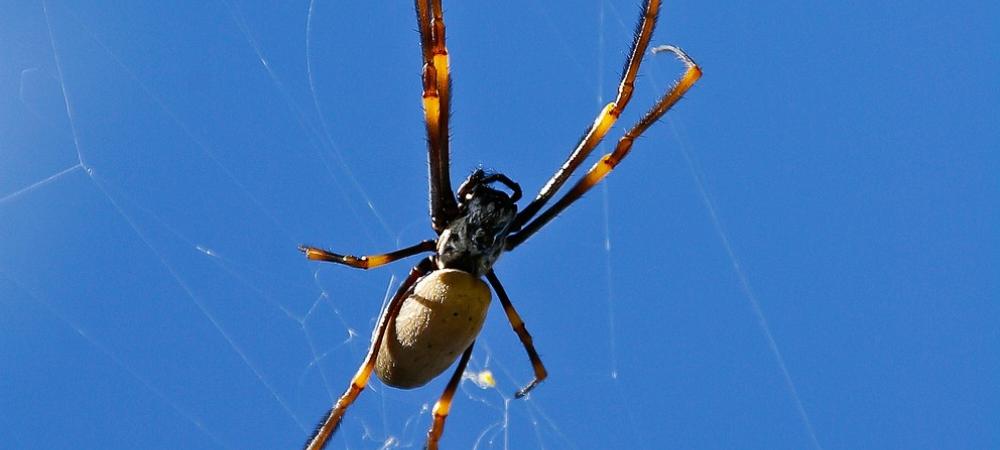The 7 Most Common Spiders in North Carolina

Spiders are an essential part of North Carolina’s ecosystem, keeping insect populations in check. Despite their reputation, most of the spiders you encounter in your home or yard are harmless and beneficial. However, some species can cause concern, especially if they’re venomous. Understanding the most common spiders in North Carolina will help homeowners identify and deal with them safely.
1. House Spider (Parasteatoda tepidariorum)
- Also Known As: Common House Spider or Domestic Spider.
- Size: Small to medium-sized, with a body length of 1/4 to 1/2 inch, with their legs extending to about 1–2 inches in total span.
- Color: Dull brown or grayish in color with darker markings or patterns, often in a "smudged" or irregular design.
- Shape: Oval-shaped body and long, spindly legs.
- Behavior: Generally non-aggressive and shy, house spiders create tangled webs in corners or undisturbed spaces like basements and attics. They are mostly nocturnal.
- Movement: Slow and methodical, often staying in one spot for long periods.
- Habitat: Prefers quiet, undisturbed areas like closets, basements, attics, and hidden crevices.
- Diet: House spiders feed on small insects caught in their webs, such as flies, moths, and ants.
- Web Type: Mess, irregular, tangled webs in dark, undisturbed places, where they quietly wait for prey.
Are House Spiders Dangerous?
No, house spiders are not dangerous to humans, although it can cause mild irritation or swelling if bitten. Their venom is used to capture and digest prey, but it poses no real threat to people.
2. Wolf Spider (Lycosidae family)
- Also Known As: Ground Spiders or Hunting Spiders.
- Size: Large, with a body length of 1/2 to 1 inch and a leg span of up to 3 inches.
- Color: Brown or gray with distinct patterns or stripes on the body.
- Shape: Robust, with a compact body and long legs that are often covered in hair.
- Behavior: Wolf spiders are solitary hunters. They do not spin webs but chase and pounce on their prey. They are active at night.
- Movement: Large, powerful legs make them fast and aggressive movers, known for their running ability.
- Location: Found in basements, gardens, or dark corners of homes.
- Habitat: Prefers to hide under rocks, leaf litter, logs, or other debris during the day.
- Diet: Carnivorous, feeding on insects, small invertebrates, and sometimes other spiders.
- Web Type: Unlike many other spiders, wolf spiders do not build webs. They are active hunters who chase down their prey, which includes insects and other small animals. They do create a small, tubular burrow or nest.
Are Wolf Spiders Dangerous?
No, wolf spiders are not considered dangerous. They are not aggressive towards humans unless threatened. Bites are painful but not life-threatening, causing swelling, redness, and sometimes localized numbness.
3. Jumping Spider (Salticidae family)
- Also Known As: Jumping Jack.
- Size: Small, typically ranging from 1/8 to 3/4 inch in size.
- Color: Come in a variety of colors, including black, brown, and gray, often with striking markings on their abdomen, including red, yellow, or white spots.
- Shape: They are easily recognized by their stocky, compact bodies and large eyes, which give them an alert, almost curious appearance.
- Behavior: Known for their incredible jumping ability and agile movements. They do not build webs for catching prey but hunt actively.
- Movement: Known for their incredible jumping ability, these spiders hunt by pouncing on their prey, which they usually stalk from a stationary position.
- Habitat: Found in a variety of environments, including homes, gardens, and forests, usually on plants or tree trunks. In homes, found on windowsills, walls, and ceilings, especially near light sources.
- Diet: Predatory, eating small insects, including ants, flies, and moths.
- Web Type: Does not build traditional webs. Instead, it creates small silken shelters in which it hides.
Are Jumping Spiders Dangerous?
No, jumping spiders are harmless to humans and are often considered beneficial as they use their venom is used to subdue small insects. Curious and alert, these spiders may even approach humans. They are non-aggressive but will jump if they feel threatened. They are unlikely to bite, but if they do, the reaction is mild, with some pain or swelling.
4. Yellow Garden Spider (Argiope aurantia)
- Also Known As: Orb-Weaver Spider or Writing Spider (due to the zigzag pattern in its web).
- Size: Medium, with a body length of 1/2 to 1 inch with a leg span of 2 inches or more.
- Color: They are often brightly colored, with black and yellow patterns on their abdomen, which is shaped like a teardrop.
- Shape: Round abdomen with a thin, long cephalothorax (head).
- Behavior: Orb-weavers are known for their characteristic spiral-shaped webs, which they rebuild daily. They are non-aggressive and generally hang upside down in the center of their webs.
- Movement: Slow and deliberate, especially when repairing or building their web.
- Habitat: Found in gardens, fields, and forests, especially in areas with dense vegetation. Known for their large, circular webs that they build between plants or on fence posts.
- Diet: They feed on a variety of insects, particularly flies, moths, and beetles, which become trapped in their webs.
- Web Type: Classic orb-shaped web, often quite large and noticeable. Their large webs are typically built in open areas, where they wait for insects to become ensnared.
Are Yellow Garden Spiders Dangerous?
No, yellow garden spiders are not harmful to humans. Non-aggressive, these spiders usually retreat to the center of their web when disturbed. Their venom is mainly used to help immobilize small prey, making them important natural pest controllers in gardens. They are very unlikely to bite. If bitten, the reaction is usually mild, with redness and swelling.
5. Cellar Spider (Pholcidae family)
- Also Known As: Daddy Longlegs.
- Size: Long-legged, slender spiders that typically measure between 1/2 to 1 inch in body length, with their legs extending to about 2 inches in span
- Color: Pale yellow or light brown or gray.
- Shape: Extremely long legs in proportion to the small, round body. Have a characteristic fragile appearance.
- Behavior: Often found in dark, damp spaces like basements and cellars. They build messy, irregular webs and are known for their quick movements and ability to shake their webs violently to escape predators.
- Movement: Slow and erratic, especially when disturbed.
- Habitat: Prefers dark, damp areas such as basements, crawlspace, cellars, attics, and corners of rooms.
- Diet: They feed on small insects, including ants, flies, and other spiders.
- Web Type: Create loose, irregular webs in corners or around cluttered areas and are notorious for vibrating their webs rapidly when disturbed.
Are Cellar Spiders Dangerous?
No, cellar spiders are not dangerous to humans and are often beneficial in reducing other insect populations. Non-aggressive and prefers to remain undisturbed. They may move quickly if threatened. They rarely bite and have a hard time even breaking the skin. If it does, reactions are generally mild, such as redness or irritation.
6. Black Widow (Latrodectus mactans)
- Size: Females are more commonly encountered, as they are larger than males, typically measuring about 1.5 inches in body length with their legs spread.
- Color: Shiny black with a distinctive red hourglass-shaped marking on the underside of their abdomen.
- Shape: Rounded, shiny body with long, thin legs.
- Behavior: Typically reclusive and shy, black widows hide in dark, undisturbed areas like sheds, basements, and wood piles. They often build irregular webs close to the ground.
- Movement: Slow and deliberate.
- Habitat: Found in dark, secluded places, both indoors and outdoors, such as sheds, garages, basements, and woodpiles.
- Diet: Black widows are carnivorous and feed on small insects, including flies, grasshoppers, and other pests that get trapped in their webs.
- Web Type: Construct irregular, tangled webs close to the ground, often in cracks or crevices.
Are Black Widow Spiders Dangerous?
Yes, black widows are highly venomous. The bite can cause severe pain, muscle cramps, nausea, and sweating, and while the venom is potent, bites are rarely fatal with medical attention. A black widow bite requires medical attention!
Learn more about black widow spiders in North Carolina.
7. Brown Recluse (Loxosceles reclusa)
- Also Known As: Fiddleback Spider or Violin Spider, due to the shape on its back.
- Size: Medium-sized, usually measuring 1/4 to 1/2 inch in body length, with long, thin legs
- Color: light to medium brown with a distinctive violin-shaped marking on their back, with the neck of the violin pointing toward the rear of the spider.
- Shape: The body is somewhat flattened with long, thin legs.
- Behavior: Brown recluses are reclusive and tend to hide in dark, undisturbed spaces. They are non-aggressive and bite only in self-defense.
- Movement: Slow and deliberate, preferring to remain hidden.
- Habitat: Found in dark, dry, quiet areas such as closets, attics, under furniture, and in basements. Outdoors, they prefer secluded spaces like under rocks or in wood piles.
- Diet: Brown recluses feed on small insects, including crickets, beetles, and other arthropods.
- Web Type: Does not build a typical web, but creates irregular flat webs named “retreats” in hidden areas, consisting of disorderly silk strands.
Are Brown Recluse Spiders Dangerous?
Yes, brown recluses are very venomous. Shy and reclusive, these spiders tend to avoid human contact. They will bite only if threatened, but their bite can cause tissue necrosis and severe reactions in some cases. The bite may cause a wound that slowly worsens. It is important to seek medical attention immediately if bitten by a brown recluse, as their venom can cause significant damage to tissues.
Learn more about brown recluse spiders in North Carolina.
Spiders in NC Homes
While the majority of spiders in North Carolina are harmless and beneficial, there are a few venomous species that homeowners should watch out for, such as the Black Widow and Brown Recluse. By understanding the characteristics and behaviors of common spiders, you can confidently identify them and handle any encounters safely. If you suspect a dangerous spider infestation or are just trying to get rid of the spiders in your home, it’s always best to contact your local pest control professionals at Peeler Environmental to ensure the safety of your family and pets.







